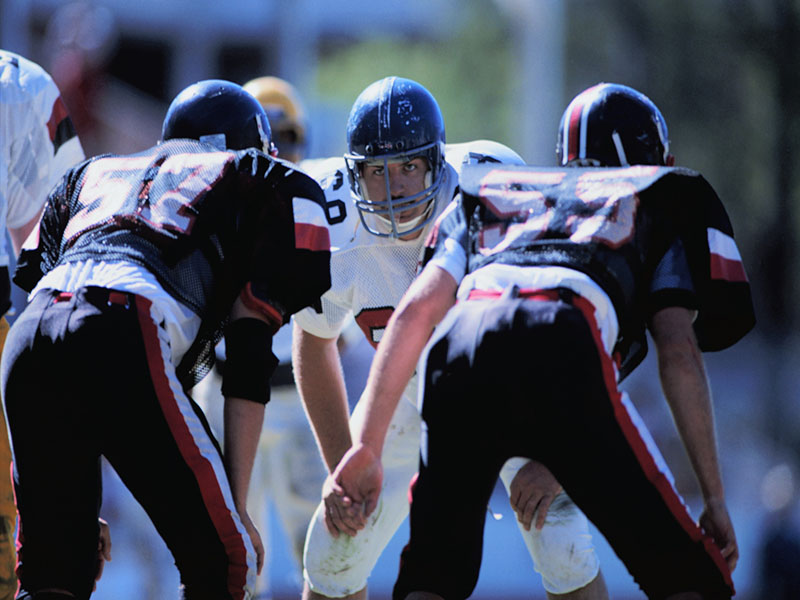By Alan Mozes
HealthDay Reporter

WEDNESDAY, Aug. 7, 2019 (HealthDay News) -- Concussions are bad news for the brain, but what about the less damaging hits to the head that are the nuts and bolts of contact sports? Do they also pose a threat?
The brain scans of 38 college football players suggest the answer is yes.
Over the course of a single season, the players collectively absorbed almost 20,000 hits. Only two of those were actually concussions. Yet, the scans revealed that by the end of the season, two-thirds of the players had suffered a notable decrease in the structural integrity of their brains.
"A non-concussive head injury is when someone hits their head but does not exhibit the signs and symptoms of concussion," explained senior study author Bradford Mahon. He is scientific director of the program for translational brain mapping at the University of Rochester Medical Center in Rochester, N.Y. That, he said, means none of the dizziness, difficulty with concentration or loss of consciousness that typify a concussion.
But prior research has suggested that, over time, repetitive exposure to these non-concussive hits increases the risk for the neurodegenerative disease chronic traumatic encephalopathy (CTE).
In search of more definitive proof of such risk, the research team, led by Adnan Hirad, outfitted the helmets of 38 college players with accelerometers.
The researchers recorded all impacts that registered a g-force of 10 or more. By comparison, the team noted that race car drivers routinely experience a g-force of 6, while car crash victims can experience a momentary impact of 100 gs.
In one season, the average g-force was pegged at 25, with half the hits exceeding that threshold, the study findings showed.
Deploying MRI scans, the team then focused on the relatively rigid midbrain, which includes the brain stem and is situated in the center of the head, under the cerebral cortex.
With the midbrain integral to the control of eye movement, trouble on this front can be another key indicator of a concussion. But Mahon said that the team ultimately found that this area was also "the 'canary in the coal mine' for repetitive subconcussive head hits."
How so? The midbrain scans revealed that "the more g-forces each player was exposed to, the more damage we measured with MRI, [even] in the absence of concussion," said Mahon.
The upshot, according to Hirad, is a recipe for cumulative brain damage. The more often a player is hit, and the higher his overall exposure to g-forces, the more his brain is at risk, even without the symptoms associated with concussions.
Lenox Hill Hospital emergency physician Dr. Robert Glatter noted that "the 'silent' nature of these impacts, without producing overt signs or symptoms of concussion, have been an ongoing concern for researchers."
"Sub-concussive hits have been on the radar of researchers over the past few decades, due to the concern that their repetitive or clinically silent effects may be cumulative over time," he explained.
"It's akin to a young pitcher who experiences repetitive elbow trauma over time by the very act of throwing a ball at high velocity," Glatter said. "When symptoms begin to develop, typically from chronic and previously clinically 'silent' inflammation, structural changes are already apparent."
The findings were published in the Aug. 7 issue of the journal Science Advances.
"Much like the early studies that linked smoking and cancer, we now have many studies, including our study, suggesting brain pathology linked to repetitive head trauma," said Hirad, who is a M.D. candidate in the medical scientist training program at the University of Rochester's School of Medicine and Dentistry. "So this raises the policy question: Do we wait for more concrete evidence, or do we act to make the game less impactful?"
But is "safe football" even possible?
Mahon said that, in his opinion, "asking whether there is a safe way to play football will probably turn out to be like asking, 'Is there a safe way to smoke cigarettes?' The best way to not accumulate damage from repetitive head hits is to not repetitively hit the head."
Hirad added, "The game will have to change in fundamental ways to protect players from these injuries. The question is will we be able to live with that sort of change?"
More information
For more on sports-related head injuries, visit the American Association of Neurological Surgeons.
Back

The news stories provided in Health News and our Health-E News Newsletter are a service of the nationally syndicated HealthDay® news and information company. Stories refer to national trends and breaking health news, and are not necessarily indicative of or always supported by our facility and providers. This information is provided for informational and educational purposes only, and is not intended to be a substitute for medical advice, diagnosis, or treatment.






